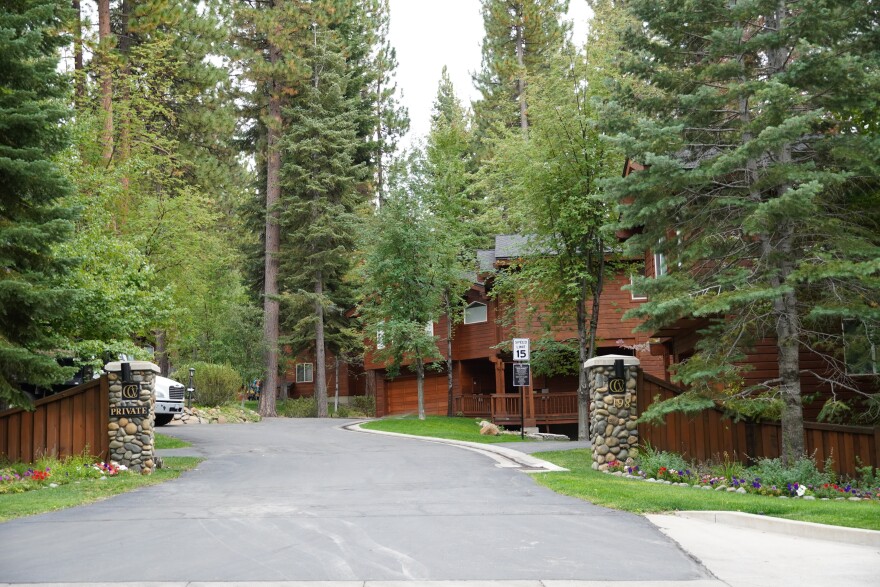Stephanie Rodriguez, a victim support advocate, grew up and works in Incline Village. For over 30 years, she called Tahoe home. But recently, a few issues forced her to leave.
“Honestly, two things, one of them was rent being so high, and another one, child care being super expensive out here, and with my two year old, I couldn't do both. It was like, either both or something way cheaper,” Rodriguez said.
Now living in Carson City, she commutes an hour each way, spending nearly $300 a month on gas. The emotional cost is even higher.
“I've been homesick, I'm not gonna lie to you, I've been home sick to Tahoe and like, I've been thinking I'm just gonna see if I can find anything for a place here, something similar to where to what I'm renting in Carson. That's like, $3,000, I cannot do that plus babysitter,” she said.
Some efforts are underway to ease the crisis. Across the region, jurisdictions — including Placer County and Washoe County — are experimenting with a mix of solutions. These include offering down payment assistance for local buyers, and incentivizing the conversion of short‑term rentals back into long‑term homes.
In Incline Village and Crystal Bay, a 2021 Washoe Tahoe housing needs study found that the region is becoming increasingly exclusive, with younger local families and essential workers being priced out and replaced by older, more affluent residents.
The area is experiencing a shrinking workforce, school enrollment changes, and rising business struggles due to a lack of stable, affordable housing. Employers reported difficulty hiring and retaining staff, with many applicants declining jobs after learning about housing costs or the need to commute from Reno or Carson City.
The report estimates a need for 1,200 new housing units by 2026, with at least 65% being affordable housing units, to meet current deficits and prepare for future retirements in the local workforce.
But given development limitations, the study has several recommendations including limiting short-term rentals.
The Tahoe-Truckee area also faces similar issues.
A 2023 update from the Mountain Housing Council for the Tahoe-Truckee region — covering the 550-square-mile area within the Tahoe Truckee Unified School District — estimated a total unmet housing demand of approximately 8,200 units.
“It's pretty significant. The number has gone down from the 2016 data that they proposed. I think that was around 11,000 so it's gone down. Now there have been a lot of efforts, such as our agency and all the other housing partners that are making a difference,” said Heidi Volkhardt Allstead, executive director of the Truckee Tahoe Workforce Housing Agency.
Most of the housing need comes from local workers who don’t have adequate housing, followed by people who commute in and seasonal workers. Approximately 66% of housing units in this region are not occupied on a full-time basis due to second-home and vacation rental use.
Justin Ozuna stands behind the bar at Sage Leaf, mixing a drink. He’s the restaurant manager, but also fills in as bartender when needed. Like many who work in Incline Village, he commutes daily from his home in Sparks — nearly an hour away.
“For me, it's about being able to just securely and financially, be able to provide for me and my daughter. I am a single dad... living in the Tahoe area would be awesome. But for me, in my life situation, it's not something that makes sense currently. Yes, it is far too expensive for me to afford to live out here, so it has kind of taken that option out for me,” Ozuna said.
In Sparks, he shares a spacious home with a roommate. In Tahoe, that same price wouldn’t get him much.
"Right now, I have a roommate. We have a three-bedroom, two-bath, 1,800-square-foot home for $2,200 a month. That includes a full backyard and garage in Sparks. At that price point around the lake, I'm not getting much,” he said.
Still, he believes any solution must be inclusive, especially for seasonal and international workers.
“I think there's a certain degree to where, yes, affordable housing is important and has to be an option, particularly for those from out of state, particularly for those from out of country that are, you know, coming here on work visas, all that kind of stuff. We need infrastructure to be able to support that,” Ozuna said.

Down the shore, on the southern edge of the lake, Nicholas Edge faces a different view of the same crisis. He works in South Lake Tahoe as a mental health case manager and pays nearly $2,200 a month for one side of a duplex. Even with more than 15 years in his field, homeownership feels out of reach.
“Honestly, I'm 37 years old. I've been in my field for 15 years, and to be in my field, being successful in my field, and still having to feel like I have to have roommates if I was on my own, it can get a little discouraging,” he said.
Housing prices have increased, while wages, even for professionals, haven’t kept up.
“I mean, I think it could definitely be a little bit less, compared to when I first moved here to now, like housing prices, as well as just rental prices, have gone up exponentially, and that's only in a few years,” Edge said.
A 2019 study by Tahoe Prosperity Center for the South Shore region — which includes South Lake Tahoe and parts of El Dorado and Douglas counties — estimated a need for 3,290 new housing units by 2026. That report highlighted that 41% of households in the South Shore are burdened by cost — this includes mortgage, rent and utilities —, with employers citing high housing costs as a key barrier to recruiting and retaining workers.
Creative housing programs aim to keep workers in the region
To address the region’s growing housing gap, agencies, nonprofits, and employers are launching new programs, expanding old ones, and finding creative ways to keep local workers in the Tahoe Basin.
In South Lake Tahoe, Sugar Pine Village is one of the most ambitious developments to date, with 248 units of affordable housing under construction on former state land.
On the North Shore, Allstead pointed to several promising employer-led solutions. She added that some businesses, like Tahoe Dave’s, have even bought homes to rent out to staff, while other employers in Placer County provide monthly housing stipends.
“Some employers I know... help offset those rental costs as well,” she said.
Programs like Placemate offer cash incentives to homeowners to convert properties, often second homes or units sitting vacant or used for short-term rentals, into long-term housing for local employees. In Truckee, since the program started in 2020, it has converted more than 200 residences to long‑term rentals, housing upwards of 500 local residents. In 2025, Placemate launched a pilot Lease to Locals program in Incline Village/Crystal Bay.
Regional data shows growing disparities across Tahoe
While a new, basin-wide housing needs assessment led by the Tahoe Regional Planning Agency is still in progress, it’s expected to reveal updated region-wide data. Recent studies from various parts of the Tahoe area reveal persistent and regionally distinct housing challenges.
Median household incomes across the Tahoe region have increased, particularly in North Lake communities. In 2022, North Shore areas reported a median income of $120,170, significantly higher than South Shore's $78,924.
Housing affordability continues to be a central issue, with the median sales price across the Tahoe region reaching $980,000 in 2024. As prices climb, so does the demand for stable rental housing, yet only 21.1% of housing units are renter-occupied, while 28.5% are owner-occupied and 44.1% of all housing units remain vacant on a seasonal basis.
Roughly half of the regional workforce commutes into Tahoe, a figure that has held steady throughout the year. Workers frequently travel from nearby communities such as Truckee, Carson City, and Reno to jobs in places like South Lake Tahoe.
Why building in Tahoe is uniquely challenging
Building more housing in Tahoe is far more complex and expensive than in other regions, due to a combination of environmental regulations, high construction costs, and limited building seasons.
“Tahoe is a beautiful place. It's a very desirable place to be... when you have a place that is really a desirable place to live, you've got a lot of demand and limited supply,” said Erin Casey, CEO of the Tahoe Housing Hub.
Strict environmental protections designed to safeguard Lake Tahoe have long regulated growth in the Basin.
“Just because you own a parcel doesn't mean you can just develop whatever you want on it,” she said..
These rules, enforced by the Tahoe Regional Planning Agency, restrict where and when development can happen, especially during snowy months when construction work is limited.
But education and outreach remain a critical part of long-term housing solutions, especially in a region where policy, permitting, and development are often complex and difficult to navigate.
Casey emphasized the need to keep residents informed and engaged.
“Part of how we are fostering that engagement is through a lot of education,” she said. “Housing is not straightforward, so we try to provide as much information as we can to educate people on different components of housing.”




